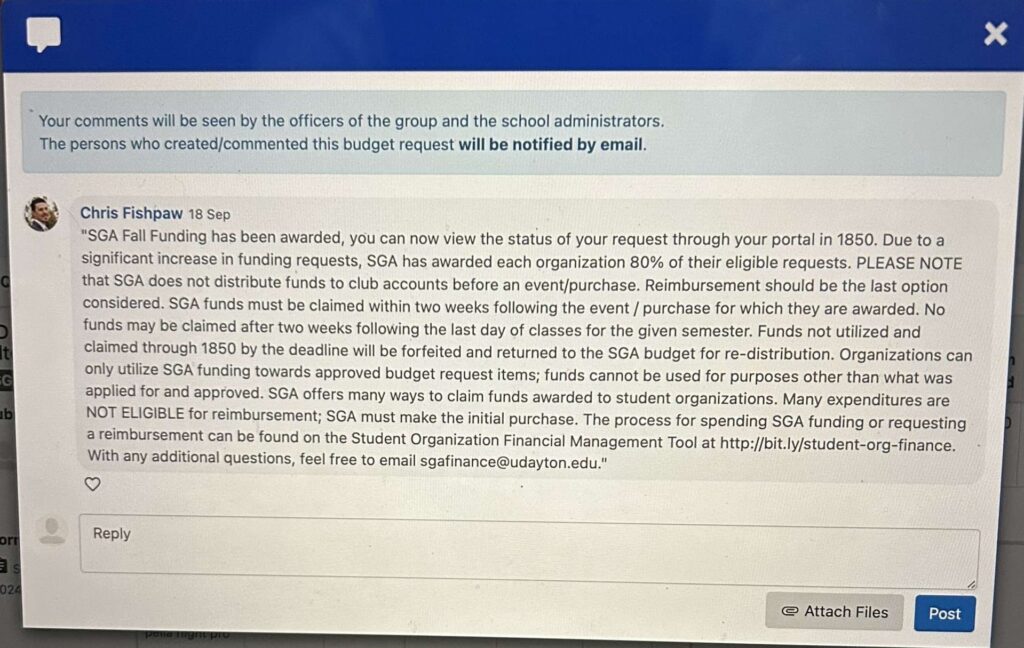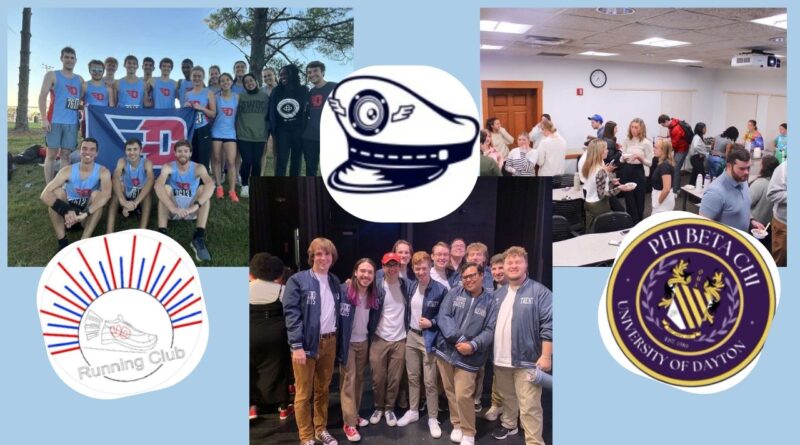The Inside Information on SGA Funding Cuts and What Campus Groups Made of Them
(UD Running Club photo courtesy of Alli Feeney; Phi Beta Chi photo courtesy of Phi Beta Chi Instagram; Audio Pilots photo courtesy of Audio Pilots Instagram)
Peter Bonasso | Contributing Writer
For UD’s s all-male a cappella group, the Audio Pilots, the journey to international championship glory begins with a single song. For Running Club, a triumph over Ohio State at the Miami Striders Invitational starts with getting the team registered. For Phi Beta Chi, UD’s professional communication fraternity, a member’s full-time position at ABC News is made possible by their first camera workshop.
While differing greatly in preparation, obstacles and duration of success, all these groups face the same crucial need: funding. In a semester when their budgets are lowered by as much as 33%, the goals of these organizations are brought into question.
Across all organizations at UD, SGA fall funding has been significantly reduced compared to previous years. The maximum request amount of $1000 was lowered to $800, and each group received 80% of their requested amount for the fall compared to 95% last spring. With such reductions, treasurers of student organizations have expressed concern and uncertainties. SGA is willing to help.
“Not having the funding means we’re stressed out a lot more on the front of making sure we get all the things we need,” said Nathan Parker, treasurer of Audio Pilots. “Getting less funding this year was especially bad because the registration fee for ICCA [International Championship of Collegiate A Cappella] and the average cost of songs increased, and that compounding on the reduced budget makes things much more difficult.”
Meghan Ryan, treasurer of Phi Beta Chi, had a similar perspective on the funding reduction. “First of all, we are very grateful for the funding SGA did give us,” Ryan said, “although we saw a 4-5% decrease from years past, which was a little surprising considering inflation and all those prices, since we requested more than normal to take that into account.” Ryan mentioned groceries, office supplies, and merchandise as areas where they had to “cut costs,” as well as payments for guest speakers and recruitment events that would cost more.
The sole reasoning treasurers received about the funding reduction came through a message on the 1850 website from Chris Fishpaw, who helps oversee the development of SGA’s budget and funding determinations: “Due to a significant increase in funding requests, SGA has awarded each organization 80% of their eligible requests.” Owen Lackey, treasurer of Running Club, questioned whether the flat 80% will be given to clubs in the future as in this semester, as well as how $800 was determined to be the maximum a group could request. For these questions and other funding details, Fishpaw was able to offer insight.

“So we had 10% more clubs request funding this year, from 123 to 135,” Fishpaw said. “We also saw significant delays in FAFSA which resulted in less first-year students coming to UD, which led in part to a reduction of SGA’s budget. Our bylaws require at least 50% of the budget to student organizations, and last year 52% was allocated and this year is 54%, so more of the funding reduction came from other expenses.”
“Based on our available budget, we try to set the cap at something that is an indication of what students are likely to receive. We adjusted the cap to $800 to signify that we had less money and students should expect less. Groups typically get more of what they asked for in the spring, and if we continue to see this trend of students requesting more in the fall than in the spring, we may be able to shift the budget to be more fall-heavy to balance that out. At this time, though, the budget is the same for the spring as for the fall.”
“In the first senate meeting, SGA approves an annual budget, and there is a line item for fall, spring, and special request funding. This year’s fall funding budget was $44,000. We assume that about 70% of the funding we give out will actually be spent. Based on that, we gave out $62,900. We take that number, all the eligible requests, and then figure out what that ratio is and give to student groups based on that ratio. Thus, this semester we could fund 80% of eligible requests, and so we split that 80% to each organization.”
Fishpaw also addressed reasons for less-than-expected funding and the issue of inflation. “If a group got less than 80% of what they asked for, that means they asked for things they shouldn’t have asked for. Any ineligible request lowers their overall amount of available funding, because they’re still only going to get an equal percent of what was eligible. Most of what we saw as ineligible were students requesting “miscellaneous funds” and “unanticipated expenses,” fundraisers (outside of those central to a group’s mission), and groceries. Sometimes students will request a dollar amount that doesn’t align with what was detailed in their request; one group asked for $400 in supplies but only $200 in expenses were detailed so that limited what they were eligible for.”
“Our department budget has taken all the reductions for the past several years. This is the first year that it touched SGA. So, while I will do everything I can to maintain SGA’s budget where it is, I cannot see it going up to assist with inflation. That said, students can advocate for that with special request funding.”
Special request funding is an option for groups either in addition to fall and spring funding or with unanticipated expenses, according to Fishpaw. Fishpaw explained more about that process.
“Special request funding doesn’t come into a formula with initial funding requests,” Fishpaw said. “It is a presentation to the student senate where they consider 11 factors, which we train them on.” The 11 factors cover questions related to how much the SGA budget can handle, the benefit to students in and outside of the club, how and whether the group can be successful without the additional funding, how the group has been funded in the past, and the request’s ranking in order of funding priorities.
Finally, Fishpaw was able to cover those priorities. “The funding priorities listed on SGA’s website have free, large-scale campus events as the top priority, student leadership and organizational development including sports competitions, conferences, and other competitions at the second priority, then capital expenses, regular supplies, and events that are open to campus but have a fee as our last priority. To date, those have not been used to change the formula for fall or spring funding, just for special request funding.”
Parker spoke to his experience with special request funding after presenting to SGA. “We got the full amount for our registration fee, 60% of what we asked for in supplies, and 0% of what we asked for in on-campus programming, because of its overlap with our funding from this semester. Overall, SGA was very pleasant and accommodating, and it was pleasant to present to them and communicate with them.”
Lackey and Ryan, although not pursuing special request funding, feel confident in the funding they do have to cover the necessary bases.
“We should be good on the amount of funds,” Lackey said. “I don’t exactly know because I don’t know what we had to do last year, but since we only have one more race (two total) I think we’ll be good.”
“On a scale of one to ten (with ten being the most concerned about funds), I would probably give like a two,” Ryan said, “just because SGA funding doesn’t factor that much into our overall funding with dues.” Ryan did mention that dues “have been lower in years past,” but still less than most fraternities at $50 per member.
Thus, despite facing a new challenge as treasurers, Parker, Lackey and Ryan will see their groups through the fall and into spring 2025. Their mission and that of other organizations has been alleviated by the work of SGA, who will continue to offer a variety of resources for funding in the year to come.

